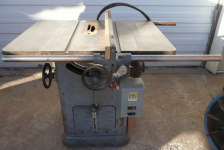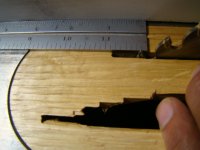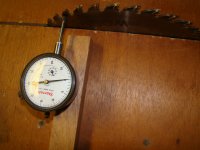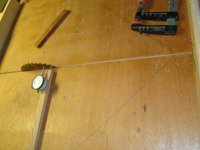I have two new 'saw' applications that I need blades for.
One is a, hard to believe, 1943, Delta/Rockwell table saw. The other is a 5 1/2 Ryobi circular saw.
The table saw has somewhat limited selection of blades that aren't super expensive. I'm still trying to workout if I can run blades larger or smaller than 8". So my questions here is would a thin kerf 42t blade be a good all choice or should I try for a higher tooth count? (The saw runs at a slow RPM).com The saw will be mostly for cutting 45 degree bevels in thin mostly 1/2" - 3/4 stock.
Pretty much the same question for the circular saw, except it won't be for bevels. While I haven't shopped I assume there is a good selection of blades available.
One is a, hard to believe, 1943, Delta/Rockwell table saw. The other is a 5 1/2 Ryobi circular saw.
The table saw has somewhat limited selection of blades that aren't super expensive. I'm still trying to workout if I can run blades larger or smaller than 8". So my questions here is would a thin kerf 42t blade be a good all choice or should I try for a higher tooth count? (The saw runs at a slow RPM).com The saw will be mostly for cutting 45 degree bevels in thin mostly 1/2" - 3/4 stock.
Pretty much the same question for the circular saw, except it won't be for bevels. While I haven't shopped I assume there is a good selection of blades available.
Premium saw blades and dados for craftsmen since 1946
Forrest blades are my preference.
For cutting plywood you want Alternate Top Bevel ..ATB
As far as size I'm not familiar with the saw you're using. If a 10" fits you will have more options for blades. Also I think bigger is better...a larger diameter will be moving the teeth faster. Thicker blades are also more stable.
Evan
Forrest blades are my preference.
For cutting plywood you want Alternate Top Bevel ..ATB
As far as size I'm not familiar with the saw you're using. If a 10" fits you will have more options for blades. Also I think bigger is better...a larger diameter will be moving the teeth faster. Thicker blades are also more stable.
Evan
Any kerf blade should do for fine cuts, tooth count is not the end-all be-all of blade selection. For a combo of accuracy and longevity I have always picked Freud blades. Forrest blades are similar quality to Freud products. I hear good things about the new offerings from Dewalt also.
As already noted, largest diameter your saw can support, and highest tooth count and would be best. When cross cutting solids, or veneer faced plywood on bevels as steep as 45dg, grain tearout on bottom side will not be uncommon - a negative hook angle can be great for that, but does require slower feed rates than ripping for smooth cuts.
Forrest, Freud or FS Tool are all decent brands - be prepared to spend at least $80 - not all carbide blades are created equal, and if you're planning on any production volume, every extra dollar spent on tooling could be considered an investment.
Forrest, Freud or FS Tool are all decent brands - be prepared to spend at least $80 - not all carbide blades are created equal, and if you're planning on any production volume, every extra dollar spent on tooling could be considered an investment.
If it's a 10" saw, I would use a 7.25" as it's an old saw and you are cutting fairly thin material. The smaller the blade, the less the torque required from the motor.Also I think bigger is better.
Thin kerf blades go through like butter. Another plus for for an older saw.Thicker blades are also more stable.
For the 5.25", I would just stick with it.
If it's a 1943 Unisaw it would be pre-Rockwell. Those are classic table saws with the repulsion bullet motor. They were only 1-1.5 HP but performed as if much more horsepower because of the large rotating mass. Even if making 45 degree cuts it will still easily turn a good 10" blade. This is what I use for general work. But I also load a ripping blade occasionally.
http://www.amanatool.com/circular-saw-blades/combination-684004.html
Hang onto that saw and restore it if it needs it. It's a keeper.
There is much information available on the old saws regarding restoration and maintenance.
VintageMachinery.org | Welcome
Dave.
http://www.amanatool.com/circular-saw-blades/combination-684004.html
Hang onto that saw and restore it if it needs it. It's a keeper.
There is much information available on the old saws regarding restoration and maintenance.
VintageMachinery.org | Welcome
Dave.
Last edited:
AFAIC, the more kcpi (knife cuts per inch) -easier to do with larger diameter blades - and slower the stock feed rate, the smoother a glue surface edge - certainly with engineered sheet goods ( MDF/PB / Plywoods)
Cal - present company excepted, not all old tools are light-duty only
Cal - present company excepted, not all old tools are light-duty only
Chris, yes, I bet in its day it would cut 24/7 and not even break a sweat. It probably weighs the same as a Studebaker and took 4 men to move. My only point was that there are ways to make the job easier on the saw and not knowing its condition, I gave those suggestions. Dave might be on to something as well. If there nothing really wrong, perhaps a little TLC is in order.
Cheers.
This here is almost identical to the one I use.
Cheers.
This here is almost identical to the one I use.
Attachments
For the circular saw look for the blades intended for battery powered saws. They are very thin, carbide tipped, cheap and actually work quite well.
Cal,
Set your saw for a square 90 degree cut in a thick piece, say 2" where the blade clears by less than 1/4" Then clamp the board to the miter gauge and do the cut, lower the blade to half thickness and repeat the cut. Does it follow perfectly or do you get a slightly deeper cut or does it even miss?
That is an important test for any saw that has seen use.
ES
Set your saw for a square 90 degree cut in a thick piece, say 2" where the blade clears by less than 1/4" Then clamp the board to the miter gauge and do the cut, lower the blade to half thickness and repeat the cut. Does it follow perfectly or do you get a slightly deeper cut or does it even miss?
That is an important test for any saw that has seen use.
ES
I stand by the fact I get a better result with a thick blade....but my experience is with reasonably stout table saws...and I'm REALLY picky.
Regardless of the quality of the blade the saw must be set up properly to work well. The slots in the table need to be parallel to the blade as does the fence. If you cut 45s then you need to check that this condition exists not only when the blade is standing up, but also when it's tilted. For me this means measuring - shimming - measuring until I get it just right.
some shots of setting up the saw.
Regardless of the quality of the blade the saw must be set up properly to work well. The slots in the table need to be parallel to the blade as does the fence. If you cut 45s then you need to check that this condition exists not only when the blade is standing up, but also when it's tilted. For me this means measuring - shimming - measuring until I get it just right.
some shots of setting up the saw.
Attachments
An article I have considered doing for a woodworking magazine is on how to add a vernier scale to gear. Once aligned adjustments are way more accurate and much much faster.
One of my table saws has digital readout on angle and blade height. The scales on the miter fence are accurate to much better than one degree and has stops at every five degrees that allow set screw accuracy to the cut length scale. So almost any idiot can make cuts more accurate than the dimensional stability of the wood. A few more years of practice and even I may achieve that.
One of my table saws has digital readout on angle and blade height. The scales on the miter fence are accurate to much better than one degree and has stops at every five degrees that allow set screw accuracy to the cut length scale. So almost any idiot can make cuts more accurate than the dimensional stability of the wood. A few more years of practice and even I may achieve that.
Hook angle and tooth count are basic parameters of saw blades, and are intrinsic to application. If ripping solid stock, that is, real wood, then hook angle must be positive and tooth count relatively low. Crosscutting calls for a higher tooth count but here's where the hook angle is very different depending on the tool in use: table saws should never have a negative hook angle since that has the effect of lifting the work piece off the surface of the machine. In contrast a chop saw or radial arm saw, otherwise termed overarm, will lift the work piece off the table unless the blade is of zero or negative hook configuration. This is NOT trivial. I acknowledge the middle ground of plywood blades on table saws but in general overarm tools have not been well served by allegedly "universal" or "all purpose" blades. Horses for courses as they say. JM(experienced)O
Well, FWIW, I've had more problem with kickbacks from an out of parallel Biesemeyer rip fence than cross cutting with a 80T negative hook angle blade on either our Delta Unisaw or newer General 10"
We don't happen to have a radial arm saw in the shop- we use either a 12" blade slider, or 14" beam saw for straight-lining and cut to length on large dimension solids and sheet goods , so I can't speak to the risks of operating one of those with any type of blade.
We don't happen to have a radial arm saw in the shop- we use either a 12" blade slider, or 14" beam saw for straight-lining and cut to length on large dimension solids and sheet goods , so I can't speak to the risks of operating one of those with any type of blade.
Last edited:
Also take a look at Ridge Carbide blades.
They are very nice, I recently bought (TS2000 10") one and I love it.
YMMV but they are a bit cheaper than Forrest Woodworker II and I think they are just as good.
They are very nice, I recently bought (TS2000 10") one and I love it.
YMMV but they are a bit cheaper than Forrest Woodworker II and I think they are just as good.
First thanks everybody, a lot of good information.
This thing could be an anchor on Steve Ballmer's yacht. 100 lbs+. I don't think I could lift it myself, maybe lift it off the table and put it back down quickly. The motor is the size of a pony keg.
As far as I know it's limited to an 8" blade. It's a small saw. The top is about 18" x 24". I can't detect any movement in the arbor. I'm going to give it a shade tree alignment today.
The only model # is cast into the side NCS 20. The serial# dated it to 1943 and it is labeled as Delta/Rockwell Homecraft.
It looks like this (but the saw only)
http://www.old-woodworking-tools.net/homecraft-rockwelldelta-table-sawjointer-combination.html
This thing could be an anchor on Steve Ballmer's yacht. 100 lbs+. I don't think I could lift it myself, maybe lift it off the table and put it back down quickly. The motor is the size of a pony keg.
As far as I know it's limited to an 8" blade. It's a small saw. The top is about 18" x 24". I can't detect any movement in the arbor. I'm going to give it a shade tree alignment today.
The only model # is cast into the side NCS 20. The serial# dated it to 1943 and it is labeled as Delta/Rockwell Homecraft.
It looks like this (but the saw only)
http://www.old-woodworking-tools.net/homecraft-rockwelldelta-table-sawjointer-combination.html
My comment was directed at newbies trying to get started at Lowe's. The big boxes are deleting things like 8 1/4 Makita type blades now that everything is 10 inch. Big blade in small table = trouble lurking. Experienced pros know what not to do after those cold sweat moments like the chunk of wood in the gut. You, chrisb, are no noob.
ezas - the size of the metal table top does not in itself limit the maximum diameter of blade, but as I lack the requisite search skills to find a citation for your exact model, it'd probably be prudent to assume the smaller 8" blade size.
Did you yet discuss the type(s) of materials to be cut on this machine? That would also have some impact on suggestions for type of blades. If only particle board or MDF, and if you can live with some chip out on bottom side of bevels, whether ripped or cross cut, then even a 40T combination blade would "work", but I'd still recommend a higher tooth count ATB or Triple Chip Ground ( e.g. Freud LU98R008 64T 5dg )
Did you yet discuss the type(s) of materials to be cut on this machine? That would also have some impact on suggestions for type of blades. If only particle board or MDF, and if you can live with some chip out on bottom side of bevels, whether ripped or cross cut, then even a 40T combination blade would "work", but I'd still recommend a higher tooth count ATB or Triple Chip Ground ( e.g. Freud LU98R008 64T 5dg )
This is the closesest I've been able to come up with: http://vintagemachinery.org/pubs/1141/3215.pdf but it's not the same model. There is not a lot on the NCS 20.
Materials for now will be 1/2" Poplar, 1/2" MDF and 1/2" BB. With 3/4" possible in the near future. Nothing other than that in the foreseeable future. No rock-hard exotics or anything like that. I like poplar cause it's so much easier to work and easier on the tools than MDF/BB. And I can get it in 1/2" size locally.
It's been quite the adventure but I have the blade square to the table and the table square to the miter slots in reference to the blade. Whew. It really helped when I found the 'extra' trunnion bolts that you can only see with the table tilted. And when I woke up this morning I didn't even know such a thing as trunnions even existed let alone that they get bolted to something.
Is 100t too fine for the 5 1/2 circular saw for what I want to cut?
Materials for now will be 1/2" Poplar, 1/2" MDF and 1/2" BB. With 3/4" possible in the near future. Nothing other than that in the foreseeable future. No rock-hard exotics or anything like that. I like poplar cause it's so much easier to work and easier on the tools than MDF/BB. And I can get it in 1/2" size locally.
It's been quite the adventure but I have the blade square to the table and the table square to the miter slots in reference to the blade. Whew. It really helped when I found the 'extra' trunnion bolts that you can only see with the table tilted. And when I woke up this morning I didn't even know such a thing as trunnions even existed let alone that they get bolted to something.
Is 100t too fine for the 5 1/2 circular saw for what I want to cut?
- Status
- Not open for further replies.
- Home
- Design & Build
- Construction Tips
- saw blade question





